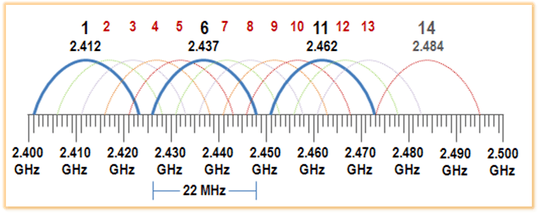The answer is "sort of" and "it depends".
If you are talking about the 2.4 GHz band - and this would seem to fit your description best - then he is pretty much talking garbage. The best band to be on is the one with the least noise - both on the main frequency and surrounding frequencies. In this case, Channel 1 sounds better and the tech sounds like he does not know what he is talking about.
If you are talking about the 5 GHz band, its a different story. Different channels in the 5 GHz band have different channel widths and different maximum transmission power - thus in the case it may very well be true that (some) higher frequencies do actually have more power. That said, the channel numbers don't match up very well with what you have posted (Channel 1 does not exist, 7 and 11 are generally not legally useable and are low bandwidth anyway)

26Technically, really nit-picky physics/math technically, channel 11 is broadcasting at a frequency that's a few MHz higher than channel 11. Mathematically, that does mean the electromagnetic waves on that channel have a tiny bit more energy. But difference completely negligible. You did the right thing by picking the one that has the least use. – mtraceur – 2016-12-08T06:36:07.363
1
@mtraceur see https://en.wikipedia.org/wiki/Free-space_path_loss
– Alnitak – 2016-12-08T09:39:30.4432@mtraceur But also with higher frequency the penetration decreases - so there is that trade off as well. – Philipp – 2016-12-08T12:46:58.040
1@mtraceur, just to join the physics nitpick party, transmitting at a higher frequency & keeping same amplitude (voltage) ==> higher power. But 20 dBm (100 mW) @ 2.412 GHz should be the same power (by definition) as 20 dBm (100 mW) @ 2.462 GHz. The 2% higher frequency would be combined 2% lower amplitude to preserve the specified power output to keep the regulators and neighbors happy. I can't say whether consumer WiFi routers do this properly though. – Joshua Huber – 2016-12-08T20:20:42.393
1Generally speaking aerials and antennae function most-optimally in the middle of the band that they're designed for. So on that basis channel 6 is the single best channel to use for 2.4 GHz wireless. – Criggie – 2016-12-09T07:10:20.033